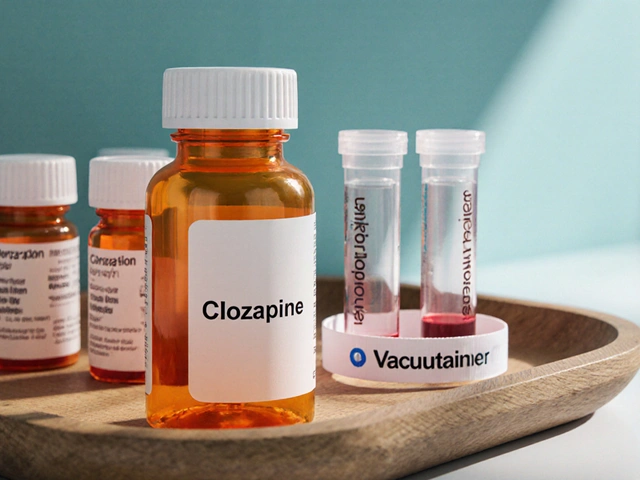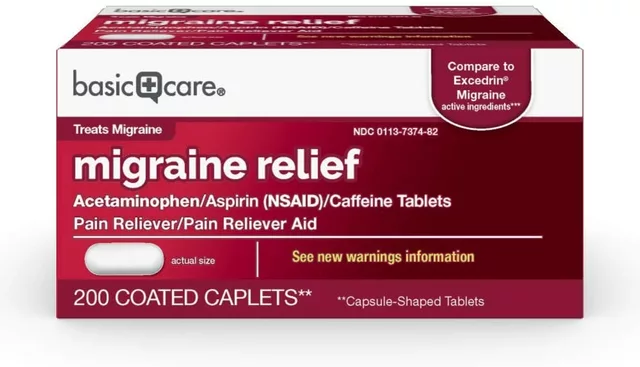Antipsychotic Medication Comparison Tool
Select your main concerns to find the best antipsychotic alternative to Risperidone:
Primary Concerns
Medical Conditions
Dosage Preference
Key Takeaways
- Risperidone works fast on dopamine receptors but can raise prolactin levels.
- Aripiprazole and Lurasidone are the lightest on weight gain.
- Olanzapine and Quetiapine excel for sleep‑related symptoms but cost more.
- Haloperidol stays cheap but brings a higher risk of movement disorders.
- Choosing the right drug means matching side‑effect profiles to the patient’s lifestyle.
Imagine you’ve just been prescribed Risperdal (risperidone) for a flare‑up of schizophrenia. Within a week you notice a sleepy haze and an unwelcome increase in breast tenderness - classic signs that the medication is pushing prolactin levels. You start Googling “Risperdal alternatives” and stumble across a maze of brand names, dosage charts, and side‑effect warnings. What you really need is a straight‑to‑the‑point comparison that tells you when to stay with Risperidone, and when a switch might save you a night of restless sleep or a few extra pounds.
How Risperidone Works
Risperidone belongs to the second‑generation, or “atypical,” antipsychotic class. It blocks dopamine D2 receptors and serotonin5‑HT2A receptors in the brain, which helps calm the hallucinations and delusions that define schizophrenia. Because it hits both pathways, patients often see a quicker reduction in positive symptoms (like hearing voices) compared with older drugs.
The drug’s half‑life sits around 20hours, allowing once‑daily dosing for most adults. It reaches steady‑state concentrations in about a week, which is why doctors usually schedule a follow‑up appointment after 7‑10days to check efficacy and side effects.
When Risperidone Is a Good Fit
Risperidone shines in several scenarios:
- Acute psychosis: Fast onset, good control of agitation.
- Mixed‑episode bipolar disorder: Stabilizes mood swings without adding a separate mood stabilizer.
- Irritability in autism spectrum disorder: FDA‑approved for children 5years and older.
- Patients without metabolic concerns: If weight gain isn’t a red flag, risperidone’s efficacy can outweigh that risk.
However, the drug raises prolactin in up to 30% of patients, which can cause galactorrhea, menstrual disturbances, or sexual dysfunction. If you’re already dealing with hormonal issues, you’ll want to look elsewhere.
Main Alternatives to Consider
Below are the most common antipsychotics that doctors compare against Risperidone. Each entry includes a brief description and the key attribute that sets it apart.
Aripiprazole (Abilify) is a partial dopamine agonist, meaning it can both stimulate and block dopamine receptors. This balance often results in the lowest weight‑gain risk among atypicals and a milder impact on prolactin.
Quetiapine (Seroquel) has strong antihistamine properties, making it a go‑to for patients who need help sleeping. Its downside is moderate metabolic side effects and a higher dose requirement for psychosis.
Olanzapine (Zyprexa) is notorious for causing weight gain, but it often delivers the most robust control of both positive and negative schizophrenia symptoms.
Haloperidol (Haldol) is a first‑generation antipsychotic. It’s cheap and powerful against severe agitation but carries a high risk of extrapyramidal symptoms (EPS) like tremors and rigidity.
Ziprasidone (Geodon) offers a favorable metabolic profile and a short half‑life (≈7hours), which can be good for patients who need rapid dose adjustments.
Lurasidone (Latuda) is another metabolically light option, approved for both schizophrenia and bipolar depression. Its main limitation is the need to take it with a full meal for adequate absorption.

Head‑to‑Head Comparison
| Drug (Brand) | FDA Approval Year | Typical Daily Dose | Half‑life (hrs) | Weight‑gain Risk | Prolactin Effect | EPS Risk | Average Monthly Cost (USD) |
|---|---|---|---|---|---|---|---|
| Risperdal (risperidone) | 1993 | 1-6mg | 20 | Moderate | High | Low‑Moderate | $45 |
| Abilify (aripiprazole) | 2002 | 10-30mg | 75 | Low | Low | Low‑Moderate | $120 |
| Seroquel (quetiapine) | 1997 | 300-800mg | 6 | Moderate | Low | Low | $80 |
| Zyprexa (olanzapine) | 1996 | 5-20mg | 30 | High | Low‑Moderate | Low‑Moderate | $110 |
| Haldol (haloperidol) | 1958 | 5-20mg | 20 | Low | Low | High | $30 |
| Geodon (ziprasidone) | 2001 | 40-80mg | 7 | Low | Low | Low‑Moderate | $130 |
| Latuda (lurasidone) | 2010 | 20-80mg | 18 | Low | Low | Low | $115 |
Which Drug Fits Which Lifestyle?
Best for weight‑concerned patients: Aripiprazole, Ziprasidone, and Lurasidone all score low on the weight‑gain column. If your main worry is the bathroom scale, ask your psychiatrist about switching from Risperidone to one of these.
Best for sleep‑disturbed patients: Quetiapine’s sedating effect can turn a restless night into a decent night’s sleep. It’s a common off‑label choice for insomnia in schizophrenia, though the dose needed for sleep is usually lower than the psychosis‑control dose.
Best for severe agitation or emergency settings: Haloperidol remains the go‑to because it works fast and is cheap. The trade‑off is a higher chance of tremors or rigidity, so doctors often add an anticholinergic (like benztropine) to blunt EPS.
Best for patients needing a mood‑stabilizing effect: Olanzapine combined with fluoxetine (the “Symbyax” blend) is FDA‑approved for bipolar depression. If you’re juggling mood swings, this combo might hit two birds with one stone.
Best for kids and teens with autism‑related irritability: Risperidone already has the green light for ages 5+. However, if prolactin‑related side effects become an issue, clinicians sometimes try Aripiprazole, which also carries an FDA indication for irritability in autism.
Common Pitfalls and Pro Tips
- Don’t stop abruptly. Sudden discontinuation can trigger rebound psychosis. Taper the dose over 2-4weeks under medical supervision.
- Watch blood work. Risperidone can raise prolactin, so baseline and periodic labs (prolactin, fasting glucose, lipids) are a smart move.
- Mind drug‑food interactions. Lurasidone needs a full 350‑calorie meal; taking it on an empty stomach drops blood levels by up to 40%.
- Check insurance formularies. Some plans cover generic risperidone but not brand‑name alternatives. A quick call to the pharmacy can save you $50‑$100 per month.
- Consider genetics. CYP2D6 poor metabolizers process risperidone slower, increasing side‑effect risk. Pharmacogenetic testing is becoming more affordable and can guide dose selection.
Bottom Line
If you’re comfortable with a modest weight gain and can tolerate higher prolactin, Risperidone remains a solid, affordable choice. If metabolic health, sleep, or movement side effects are top concerns, the alternatives listed above give you a clear path to a better‑matched medication. Always discuss any switch with your prescriber, because the right dose, titration schedule, and monitoring plan can make the difference between feeling like yourself again or stuck in a new set of side effects.
Frequently Asked Questions
How long does it take for risperidone to start working?
Most patients notice a reduction in hallucinations or delusional thoughts within 1‑2weeks, but full stabilization can take up to 6weeks. Doctors usually schedule a follow‑up at the 1‑week mark to adjust the dose.
Why does risperidone raise prolactin?
Risperidone blocks dopamine D2 receptors in the pituitary gland. Dopamine normally suppresses prolactin release, so when the pathway is blocked, prolactin levels rise, leading to side effects like breast swelling or menstrual changes.
Can I switch from risperidone to aripiprazole without a washout period?
Because both drugs block dopamine receptors, a direct cross‑taper is often recommended. Doctors usually lower risperidone over a week while simultaneously introducing a low dose of aripiprazole, then gradually increase the new med.
Is risperidone safe for pregnant women?
Animal studies show no major teratogenic effects, but human data are limited. The FDA places it in pregnancy category C, meaning risk cannot be ruled out. Discuss potential benefits and risks with your obstetrician.
What should I do if I experience severe tremors while on risperidone?
Severe tremors may indicate extrapyramidal symptoms. Contact your prescriber promptly - they might add an anticholinergic medication or lower the dose. Do not stop the drug abruptly.









Gloria Reyes Najera September 28, 2025
Risperdal is just another American pharma trick that makes us fat and hormone crazy.
lee charlie September 30, 2025
Hey, I totally get how confusing these meds can be. If weight gain is your main worry, trying aripiprazole or lurasidone might be worth a chat with your doc. They’re known for being lighter on the scale and don’t usually jack up prolactin as much.
Greg DiMedio October 3, 2025
Wow, another exhaustive chart about antipsychotics-because we all have time to read tables while dealing with hallucinations. Might as well add a footnote on how “cheapest” means “cheapest side‑effects” for the brave.
Badal Patel October 5, 2025
Esteemed colleagues, it is incumbent upon us, as custodians of psychiatric pharmacotherapy, to scrutinize meticulously the comparative efficacy and metabolic ramifications of the agents enumerated herein; nevertheless, one must also consider the idiosyncratic patient proclivities that transcend mere statistical aggregates.
KIRAN nadarla October 7, 2025
While the article presents an informative matrix, one must note the occasional misuse of “its” versus “it’s” within the descriptive paragraphs; such inaccuracies, albeit minor, could undermine the credibility of the data presented, especially for readers reliant upon precise grammatical conventions.
Kara Guilbert October 10, 2025
It is absolutely unacceptible to ignore the ethical implications of prescribing a drug that can cause prolactin spikes and affect women’s health-doctors need to think about morality, not just profit.
Sonia Michelle October 12, 2025
From a philosophical standpoint, medication choices echo the age‑old debate of freedom versus determinism: we seek to free the mind from pathological chains, yet each drug deterministically molds our neurochemistry. Balancing efficacy with quality of life is a moral imperative, and the data here empower patients to participate in that ethical dialogue. By understanding each agent’s profile, we can co‑create treatment plans that respect both the science and the individual’s lived experience.
Neil Collette October 14, 2025
And to add to that, the grammar police can’t save a patient from EPS-take haloperidol, it’s cheap but you’ll be shaking like a leaf if you ignore the movement side‑effects. So, while I appreciate the nitpicking, let’s focus on the real clinical stakes.
James Lee October 17, 2025
Sure, the chart is comprehensive, but anyone with a basic grasp of psychopharmacology knows the differences before the first coffee break. Highlights? Just the obvious.
Dennis Scholing October 19, 2025
Indeed, weight management is a pivotal concern; however, it is equally vital to monitor fasting glucose and lipid panels when initiating any atypical antipsychotic, as metabolic syndrome can develop insidiously.
Kasey Lauren October 21, 2025
Sounds like you’ve got a solid overview-good luck finding the right match!
joshua Dangerfield October 24, 2025
I echo the sentiment that patient autonomy is central; nevertheless, clinicians should also weigh pharmacogenomic data where available, as CYP2D6 variations markedly influence risperidone plasma levels.
Abhimanyu Singh Rathore October 26, 2025
The comparative analysis presented in the article serves as a valuable primer for both novices and seasoned clinicians alike, offering a concise yet comprehensive overview of the pharmacodynamic and pharmacokinetic profiles of each agent. It is commendable that the authors have included practical considerations such as cost and dosing convenience, which are often neglected in academic reviews. However, one must be cautious not to oversimplify the nuanced interplay between efficacy and side‑effect burden, as patient heterogeneity invariably dictates individualized responses. For instance, while aripiprazole boasts a favorable metabolic footprint, its partial agonist activity at D2 receptors may precipitate akathisia in susceptible individuals. Conversely, olanzapine’s robust antipsychotic potency is frequently accompanied by substantial weight gain and dyslipidemia, necessitating vigilant metabolic monitoring. The inclusion of haloperidol as a cost‑effective option is appropriate for acute agitation, yet the higher risk of extrapyramidal symptoms warrants prophylactic anticholinergic coverage in many cases. Moreover, the discussion of lurasidone rightly emphasizes the necessity of a substantial meal for optimal absorption-a practical detail that can affect therapeutic outcomes. It is also noteworthy that ziprasidone’s QTc prolongation potential, albeit modest, should be evaluated against baseline cardiac risk factors before initiation. The article’s tabular format, while visually accessible, could benefit from a column indicating the receptor binding affinities, thereby elucidating the mechanistic basis for observed side‑effects. Additionally, a brief mention of the role of pharmacogenomics, particularly regarding CYP2D6 and CYP3A4 polymorphisms, would enhance the clinician’s decision‑making toolkit. In terms of patient adherence, the once‑daily dosing of risperidone and lurasidone offers a clear advantage over multiple‑daily regimens required for some alternatives. Yet, the potential for prolactin elevation with risperidone underscores the importance of baseline hormonal assessment, especially in reproductive‑age patients. The authors correctly advise against abrupt discontinuation, a point that cannot be overstated given the risk of rebound psychosis. From a health‑economics perspective, the cost differentials highlighted reinforce the need for insurance formularies to accommodate at least one metabolically neutral option. Finally, the recommendation to consider patient lifestyle-sleep patterns, dietary habits, and activity levels-is an exemplary patient‑centered approach. In sum, the synthesis provided lays a solid foundation, but ongoing clinical judgment and individualized assessment remain the keystones of optimal antipsychotic selection.
Stephen Lewis October 28, 2025
Dear colleagues, I would like to emphasize the importance of systematic monitoring when transitioning between antipsychotics, particularly with respect to prolactin levels, weight metrics, and movement disorders, to ensure a seamless therapeutic continuum.
Lynn Kline October 30, 2025
What an enlightening guide-kudos to the author for distilling such complex data into a readable format! Your effort lights the path for many.
Jessica Taranto November 2, 2025
I find the comparison of half‑life particularly useful; could we also consider patient preference for dosing frequency when evaluating options?
akash chaudhary November 4, 2025
Frankly, the article glosses over the critical fact that risperidone’s D2 blockade is so potent that it often eclipses newer agents in acute psychosis control; anyone ignoring this is willfully blind.
Adele Joablife November 6, 2025
While the overview is solid, it fails to address the ethical dilemma of prescribing high‑risk drugs to vulnerable populations without exhaustive counseling.
Peter Jones November 9, 2025
All things considered, the key takeaway is to match medication profiles with individual patient priorities, fostering collaboration between prescriber and patient for the best outcome.